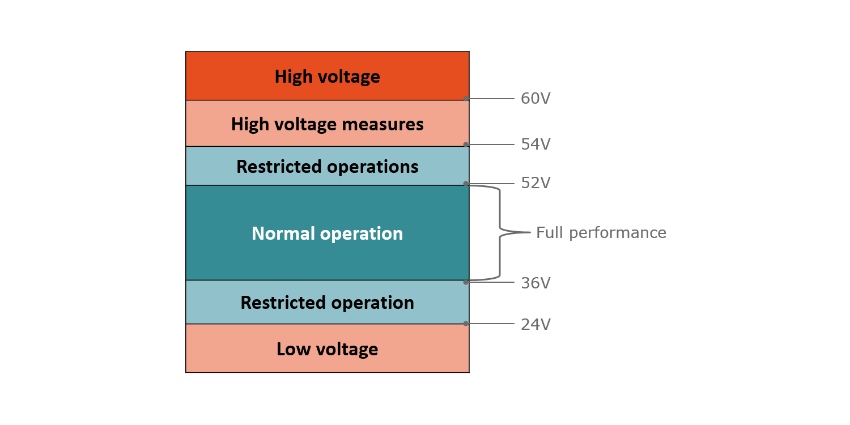In this third blog on electrification of the powertrain, we try to understand firstly why 48-volts and then take a look at some of the different mounting options for 48-volt starter generators.
The 48-volt starter generator
2017 brought significant growth across the whole spectrum of the automotive industry – from car OEMs to small component manufacturers. One topic which gained increasing popularity is vehicle electrification and specifically the 48-volt architecture. In fact, the plentiful results which the term ’48-volt‘ (or ’48V’) produces in any search engine, shows that this engineering solution for vehicle systems is here to stay.
In my previous blog ‘The appearance of 48-volt mild hybrid’, I briefly introduced the new 48-volt vehicle architecture and how it could differ from the established 12-volt. Here, I will touch on the reasoning behind the new voltage level and delve into one of its main applications – the 48-volt starter generator.
Why 48-volt?
An obvious initial question is: “But why exactly 48-volt?”. This is an important question, bearing in mind that in the late 1990s a 42-volt electrical power standard was proposed to replace the 12-volt standard. Although it did not gain momentum, it’s purpose was to address some of the same issues we face today, such as more powerful electrically-driven accessories and lighter wiring harnesses. However, there are two main reasons for selecting 48-volts as the nominal value – safety and efficiency.
A major concern when increasing voltage is the potential safety hazard it may impose on us humans. While some continue to debate whether 48-volt is safe enough, this voltage level provides the additional power required without drifting into the ‘high-voltage’ domain. Figure 1 shows the different voltage levels of operation for the 48-volt battery. The limit of 60-volts (DC) is the upper safety maximum before the battery voltage is considered too dangerous – as mentioned in ZVEI’s document ‘Voltage Classes for Electric Mobility’. Optimal performance is achieved in the ’normal operation‘ range, however electronic components within the vehicle should be able to withstand worst case high-voltage conditions.

Figure 1: Safety voltage margins
As I’ve previously stated, the current 12-volt system is unable to cope with the growing demand for electrical power within conventional vehicles. However the 42-volt proposal was a complete replacement of the 12-volt electrical architecture while 48-volt complements it. The 48-volt battery simply adds an additional power source for new applications which also contribute to a smoother driving experience. Furthermore, the size and cost of wiring and components is significantly reduced due to the higher voltage of the 48-volt battery.
A closer look at the 48-volt starter generator options
Having a similar appearance as the car alternator (Figure 2a) but slightly bigger in size, the 48-volt starter generator’s initial topology position is at the engine’s belt. The belt-driven starter generator (BSG), also known as P0 architecture (Figure 2b) is a cost-effective solution which can provide up to a 15% reduction in CO2. Looking at some boost recuperation systems (such as Bosch’s), the maximum power ratings are around 10 kW for mechanical output in boost mode and 12 kW for electrical output during recuperation – both at 48-volts. While these numbers are rated for short periods of time, the BSG’s continuous power can reach up to 5 kW with maximum efficiency of 85%.
Figure 2a and 2b: Car alternator and P0 starter generator topology
However with tightening emission regulations, automotive Tier 1 suppliers have developed different starter generator topologies to further reduce the CO2 footprint of 48-volt mild hybrid vehicles. In ascending order, these configurations offer better emission reduction but become increasingly complex and costly.

Figure 3: 48-volt mild hybrid starter generator topologies
Crankshaft mounted starter generator (P1)
As the name suggests this solution has the starter generator mounted directly on the crankshaft (which converts the linear motion of pistons into rotary motion). This provides higher torque than the P0 architecture due to the absence of a belt drive, and with no belt losses there is greater efficiency. The maximum power required is 10 kW but the efficiency goes up to 94%. However one significant limitation of this solution is that torque requirements can be demanding, due to no torque/speed ratio between the crankshaft and the starter generator. An example of this topology is the 2010 Mercedes-Benz S400 BlueHybrid.
Shaft mounted machine (P2/P3)
Both P0 and P1 architectures are mounted on the engine, but there are other mounting options such as having the 48-volt electrical machine on the gearbox’s input/output shaft (P2/P3 respectively). By providing a mechanical disconnect, this translates to improved energy flow efficiency and allows for the provision of hybrid functions (e.g. e-drive).
The P2 architecture is ether integrated into the transmission on the input shaft or attached on the side, and results in increased energy recuperation and electrical drive capabilities. Mounting the solution on the output shaft (P3), provides the highest level of the above-mentioned benefits. The obvious disadvantage of the shaft mounted electrical machine is the cost of integration.
Rear axle mounted electrical machine (P4)
The ultimate architecture at this time involves mounting at the rear axle drive (P4). This provides the vehicle with 4-wheel drive capabilities, with the combustion engine at the front and the electrical machine at the back. Maximum power requirement of the P2-P4 architectures can reach up to 21 kW with an efficiency of 95%. Moving the starter generator closer to the rear axle also provides more hybrid functionality to the vehicle. The new 48-volt machine is able to reduce the CO2 emissions by up to 21% in urban driving environment depending on its architecture.
What is more, this high-power application requires a significant portion of electronics to drive it. Naturally power MOSFETs play a key role in these electronic modules, but they need to be capable of withstanding worst case scenarios such as excessive currents and thermal leakages. Hence, the topic of my next blog will be to delve into the semiconductor content inside 48-volt applications such as the starter generator. Stay tuned!